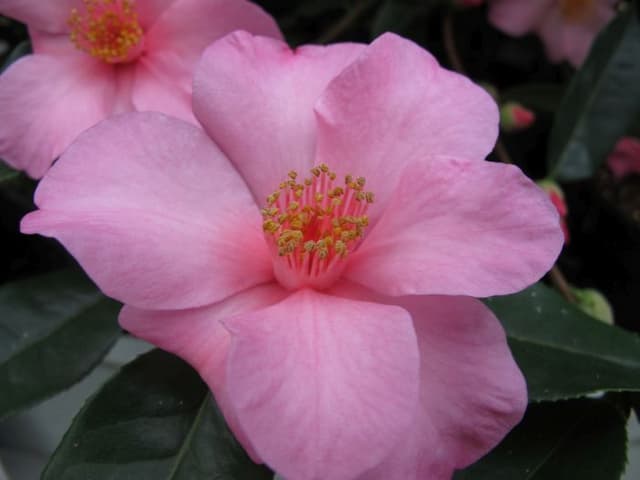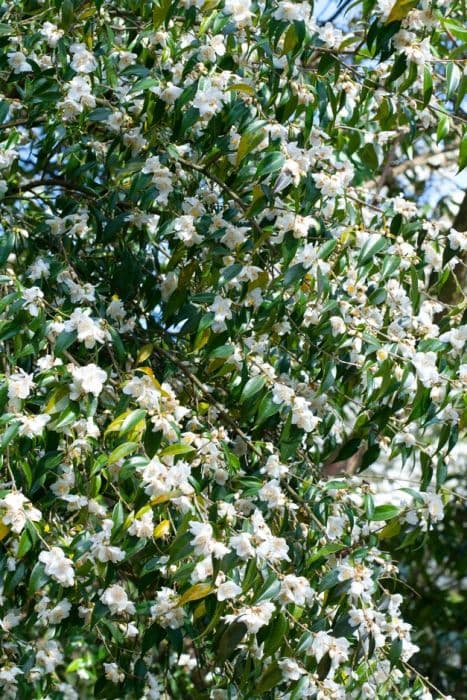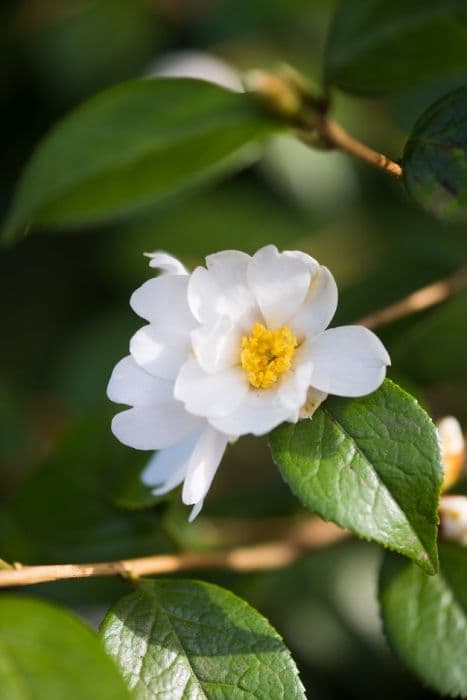Williamsii Camellia Camellia × williamsii 'Glenn's Orbit'

ABOUT
Camellia × williamsii 'Glenn's Orbit' is distinguished by its beautiful and showy flowers that are typically large and have an opulent appearance. The blooms can come in a palette of colors such as pinks, whites, reds, and sometimes with variegated hues combining these colors in different patterns such as stripes or speckles. The petals are usually arranged in a dense formation, which may either be ruffled, overlapping, or exhibiting a more orderly arrangement that could be described as formal or peony-like. The glossy, evergreen leaves provide a lush backdrop to the flowers, with their dark green color and leathery texture. They are typically oval or elliptical in shape with a smooth edge, and they may have a slight point at the tip. These leaves are generally arranged alternately along the stems, which gives the plant a dense and well-structured appearance. Although we cannot discuss the size of the plant, Camellia × williamsii 'Glenn's Orbit' usually has a shrub-like growth habit that can be described as upright and well-branched, which contributes to its appearance as a compact and tidy addition to any garden or landscape setting. The plant's growth pattern helps in supporting the profusion of flowers it tends to produce, creating an impactful floral display during its blooming season. Please note that while this description focuses on the visual characteristics of the 'Glenn's Orbit' variety, individual plants may exhibit slight differences in color and form due to environmental factors and cultivation practices.
About this plant
 Names
NamesFamily
Theaceae
Synonyms
Williamsii Camellia, Hybrid Camellia
Common names
Camellia × williamsii 'Glenn's Orbit'.
 Toxicity
ToxicityTo humans
The Camellia Williamsii hybrid 'Glenn's Orbit', commonly referred to as camellia, is not known to be toxic to humans. Ingesting parts of this plant, including leaves or flowers, typically does not lead to poisoning or serious health consequences. However, as with any plant material not intended for consumption, individual sensitivities can vary, and ingesting plant parts might cause mild gastrointestinal discomfort in some people.
To pets
Camellia Williamsii 'Glenn's Orbit', commonly known as camellia, is generally considered non-toxic to pets as well. This includes both cats and dogs. Ingesting parts of the camellia plant is unlikely to result in poisoning or produce significant adverse health effects in pets. However, ingestion could potentially cause some mild gastrointestinal upset, such as vomiting or diarrhea, particularly if the pet consumes a large quantity of the plant material. As with any non-food plant, it is prudent to prevent pets from eating it to avoid any potential discomfort.
 Characteristics
CharacteristicsLife cycle
Perennials
Foliage type
Evergreen
Color of leaves
Dark green
Flower color
Pink
Height
8-10 feet (2.4-3 meters)
Spread
6-8 feet (1.8-2.4 meters)
Plant type
Shrub
Hardiness zones
7
Native area
East Asia
Benefits
 General Benefits
General Benefits- Ornamental Value: Camellia × williamsii 'Glenn's Orbit', commonly known as Williamsii camellia, has attractive flowers and evergreen foliage that add beauty to landscapes and gardens.
- Long Blooming Period: This variety typically has a prolonged blooming season, providing color and interest throughout late winter and spring.
- Shade Tolerance: It can grow well in partial shade, making it a good choice for adding color to shaded areas.
- Drought Resistance: Once established, it has moderate drought resistance, requiring less frequent watering compared to other plants.
- Privacy and Screening: The dense growth habit of Williamsii camellia can be used to provide privacy screens or windbreaks in gardens.
- Attracts Pollinators: Its flowers can attract bees and other pollinators, which are essential for the health of nearby plants and the ecosystem.
- Variety in Landscaping: Available in a variety of forms such as shrubs and trees, it offers flexibility in landscape design.
- Low Maintenance: Requires minimal pruning and care once established, making it an easy plant to maintain for gardeners of all skill levels.
- Cold Hardiness: It has a moderate tolerance to cold temperatures, allowing it to be grown in many temperate regions.
- Year-Round Interest: The evergreen foliage provides visual interest in the garden even when the plant is not in bloom.
 Medical Properties
Medical PropertiesThis plant is not used for medical purposes.
 Air-purifying Qualities
Air-purifying QualitiesThis plant is not specifically known for air purifying qualities.
 Other Uses
Other Uses- Camellia × williamsii 'Glenn's Orbit' can be used as a natural fabric dye, providing a range of colors from soft beige to pink depending on the mordant used.
- The petals of Glenn's Orbit can be used in the culinary world as an edible decoration for salads and desserts for their ornamental appeal.
- In crafting, dried petals of the Camellia × williamsii 'Glenn's Orbit' can be used to make biodegradable confetti or potpourri, combining beauty with eco-friendliness.
- The wood from a Camellia × williamsii 'Glenn's Orbit' can be used in fine woodworking for creating small objects like inlays or jewelry due to its dense and smooth texture.
- The plant can act as a natural barrier or hedge in gardens due to its dense foliage, providing privacy and wind protection.
- Artists may use the pigments extracted from the flowers of Glenn's Orbit for watercolor painting, offering a unique range of hues.
- Leaves of the Camellia × williamsii 'Glenn's Orbit' can be used in the creation of miniature or fairy gardens, adding a lush, evergreen element to the scenery.
- For photographers and filmmakers, the dense and vibrant blooms of the Glenn's Orbit serve as an ideal backdrop for photo shoots or filming scenes requiring natural beauty.
- The fallen blooms of Glenn's Orbit can be collected and used to create natural flower paths or decoration around the garden, adding color and texture to the landscape.
- Enthusiasts of natural inks can use the Camellia × williamsii 'Glenn's Orbit' petals to experiment with creating their own botanical inks for calligraphy or art projects.
Interesting Facts
 Feng Shui
Feng ShuiThe Camellia is not used in Feng Shui practice.
 Zodiac Sign Compitability
Zodiac Sign CompitabilityThe Camellia is not used in astrology practice.
 Plant Symbolism
Plant Symbolism- Admiration: Camellias are often associated with deep admiration for someone's qualities and spirit, reflecting respect and esteem.
- Perfection: The flawless beauty of the Camellia flower symbolizes the strive for perfection and excellence.
- Love: Camellias, especially red ones, express deep romantic love and passion, celebrating relationship bonds.
- Longevity: With its hardy nature and long flowering season, the Camellia symbolizes long and prosperous life.
- Gratitude: The Camellia is often given as a gesture of thanks, emblematic of gratitude and appreciation.
 Water
WaterThe Williamsii Camellia should be watered deeply to ensure that the root zone is thoroughly moistened, generally receiving about 1 to 1.5 gallons of water per week depending on soil conditions and climate. In hot or windy weather, the frequency may need to increase to maintain consistent soil moisture, while in cooler or rainy conditions, watering can be reduced. It's important not to let the soil dry out completely, but also to avoid waterlogging as this can lead to root rot. Water in the morning to allow leaves to dry out during the day, which helps prevent disease.
 Light
LightWilliamsii Camellias prefer bright, indirect light or partial shade, avoiding the hot afternoon sun. The best spot for these camellias would be a location that receives morning sunlight and afternoon shade, or dappled sunlight throughout the day, which provides sufficient light without causing leaf scorch.
 Temperature
TemperatureWilliamsii Camellias thrive in moderate temperatures and do best in a range between 65°F to 75°F. They can survive brief periods of temperatures as low as 10°F but prolonged exposure to temperatures below freezing can damage the plant. It is essential to protect the camellia from extreme cold by providing a sheltered position or using frost cloths when temperatures drop significantly.
 Pruning
PruningPruning of the Williamsii Camellia should be done after flowering in spring to shape the plant and remove any dead or diseased branches. The aim is to open up the plant to light and air circulation, which encourages healthy growth and flowering. Prune sparingly as camellias do not require heavy pruning; simply cut back to a bud or leaf joint to promote new growth.
 Cleaning
CleaningAs needed
 Soil
SoilWilliamsii Camellia thrives best in acidic soil with a pH of 5.5 to 6.5. A blend of 2 parts peat moss, 1 part perlite, and 1 part organic compost would create an ideal soil mix, offering good drainage and fertility.
 Repotting
RepottingWilliamsii Camellias generally need repotting every 2 to 3 years, ideally in the spring before the growing season begins or after flowering to minimize stress on the plant.
 Humidity & Misting
Humidity & MistingWilliamsii Camellias prefer high humidity levels, around 40% to 50%. It's beneficial to maintain consistent humidity for optimal growth and flowering.
 Suitable locations
Suitable locationsIndoor
Place Williamsii Camellia in bright, indirect light with high humidity.
Outdoor
Plant in partial shade, sheltered from harsh sun and winds.
Hardiness zone
7-9 USDA
 Life cycle
Life cycleThe life of a Camellia × williamsii 'Glenn's Orbit', commonly known as Glenn's Orbit Camellia, begins with seed germination occurring in a warm, moist environment. The seedling stage follows, characterized by the emergence of the first true leaves which are glossy and dark green. After a few years of growth, the young plant enters the juvenile phase, where it starts to establish a strong root system and robust foliage but does not yet flower. As the camellia matures into adulthood, it enters the flowering stage, producing large, showy flowers usually in shades of pink, red, or white during late winter to spring. Following pollination, the plant forms seed capsules, which upon ripening, release seeds to begin the next generation. In ideal conditions, Glenn's Orbit Camellia can live for several decades, with flowering becoming more prolific as the plant ages.
 Propogation
PropogationPropogation time
Spring to Early Summer
Camellia × williamsii 'Glenn's Orbit', commonly known as a hybrid Camellia, can be effectively propagated through semi-hardwood cuttings. This is among the most popular methods of propagation for camellias and is typically done in late summer to early fall after the current year's growth has begun to harden. To propagate by cuttings, a gardener would take a 4 to 6-inch cutting from a healthy, disease-free branch, making sure it contains several sets of leaves. The lower leaves should be removed, and the cut end can be dipped in a rooting hormone powder to encourage root development. The cutting is then planted in a mixture of peat and perlite or sand, ensuring that the mixture stays moist but not wet. It's crucial to provide a warm environment and consistent humidity, which can be achieved by covering the cutting with a plastic bag or placing it in a greenhouse. Root development can take several weeks to a few months, after which the new plant can be gradually acclimatized to ambient conditions before being planted out.









